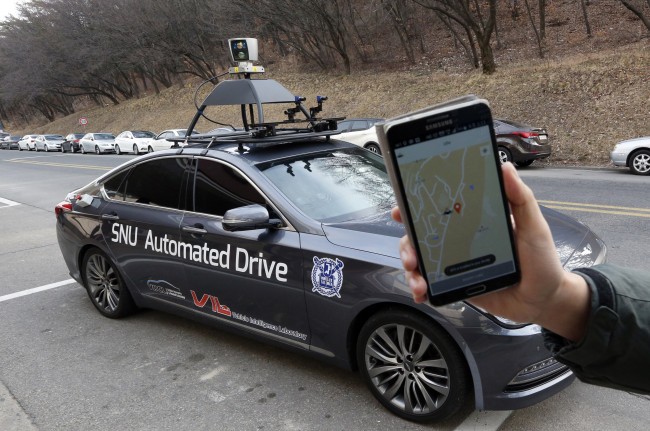Popular Reads
Top Results
Can't find what you're looking for?
View all search resultsPopular Reads
Top Results
Can't find what you're looking for?
View all search resultsFully self-driving taxi on South Korean roads by 2020
Change text size
Gift Premium Articles
to Anyone
A
team from Seoul National University is set to unveil a newer and more advanced version of its autonomous car Snuber later this year, joining a global race to develop self-driving cars.
Snuber is an app-based self-driving taxi that was unveiled in November and has since been used by college students as a ride-hailing service within the campus -- while also being used as a prototype for its upgraded version.
“Snuber has already driven more than 2,000 kilometers on the campus without an accident. We plan to unveil more upgraded version of the driverless car in the second half of this year,” Seo Seung-woo, professor of Seoul National University’s department of electrical and computer engineering, said in an interview with The Korea Herald at his office. He is also a director at the Intelligent Vehicle IT Research Center.
The self-driving taxi is currently able to perform multiple tasks, such as cutting in, overtaking a car and pulling over to the shoulder in case of an emergency.
It also went through a driving test on a snow-covered path in December when there was heavy snowfall in Seoul. Despite bad visibility due to the snow, Snuber was able to drive at a speed of 30 kilometers per hour, avoiding buses and cars coming from the opposite side and pedestrians crossing at the crosswalk, according to the professor.
“Snuber might be the first driverless car globally to undergo tests in such weather conditions considering that Google’s self-driving car is normally tested out in California’s mild weather,” he said.
His team is currently testing Snuber at “level three,” but it aims to roll out a fully self-driving car, “level four,” in the market in five years. The vital technology for “level four” is artificial technology that would allow the car to think and make flexible decisions like humans do, he said.
“This is so tricky and the most challenging element. Let’s say, a car is programmed to never violate traffic rules such as crossing the center line or stop line. The inflexible decisions can cause traffic congestion or read-end collisions,” he said, adding, “That said, if the car is programmed to flexibly violate traffic rules, that may also lead to car accidents.”
In order to reduce the dilemma, the self-driving cars should be programmed with an enormous amount of data so it can make more flexible decisions, he said. In terms of big data, Google has so far been greatly ahead of other automakers, having logged more than 3.8 million kilometers in the past six years.
Seo expected Snuber would also gain more data soon by driving on highways and regular roads outside the campus as the nation’s traffic rules are expected to be revised this year.
“Hegemony in the future automotive industry is expected to shift from automakers with hardware capacity to artificial intelligence capacity,” he said.










